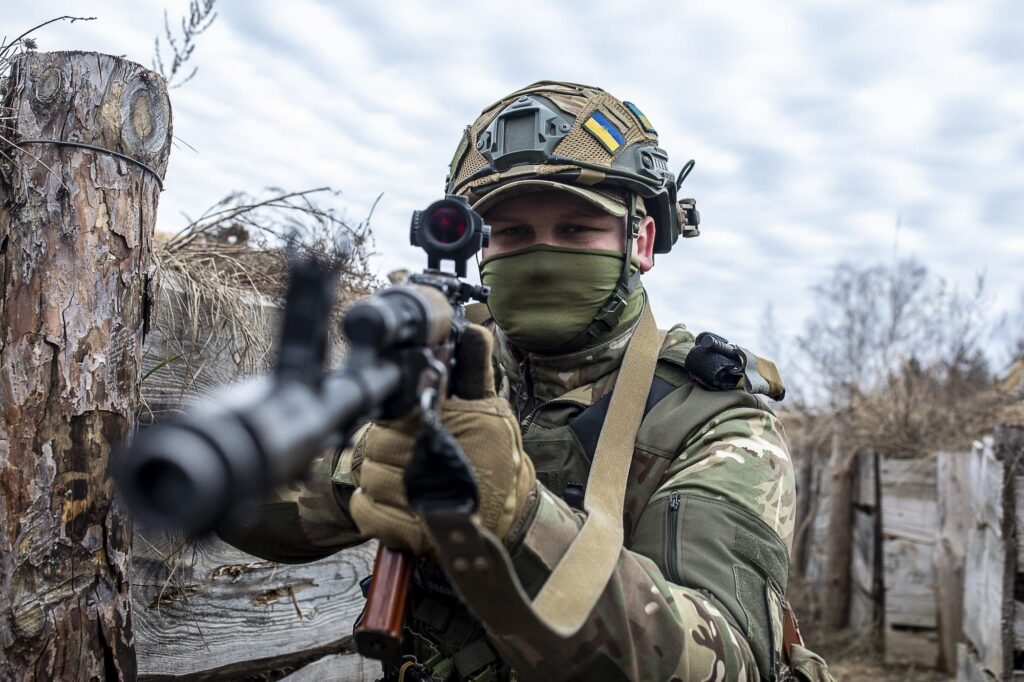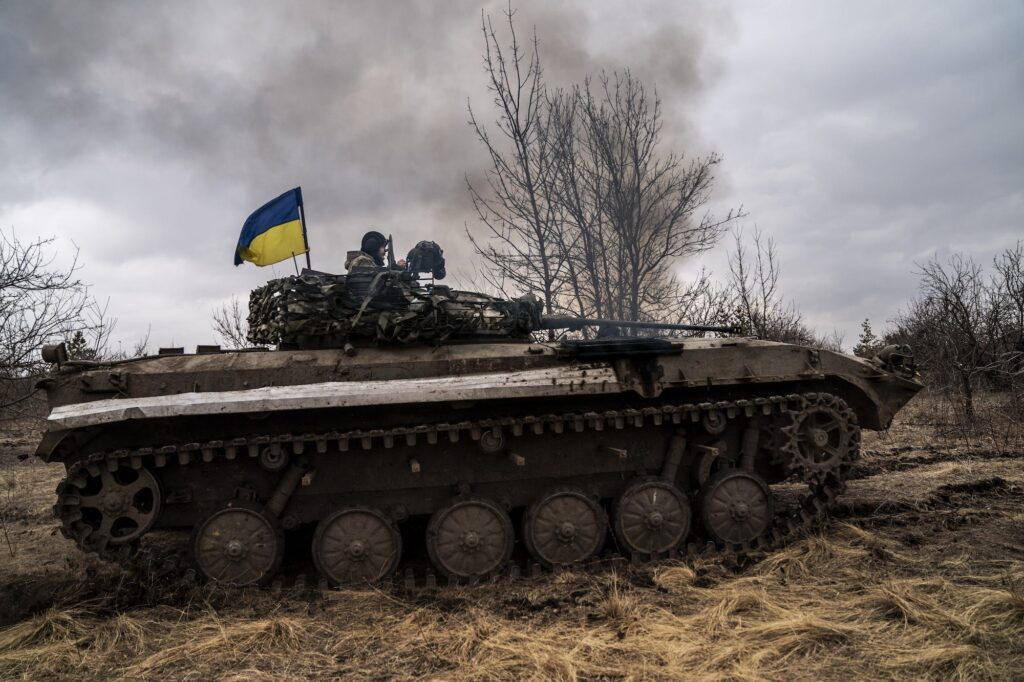- An MIT professor envisioned a defensive strategy in 1994 for Ukraine to survive a Russian attack.
- Barry Posen anticipated Ukraine's challenges even though the world looked different 30 years ago.
- He foresaw the primacy of airpower and that Russia's foremost weapon was ground firepower.
In 1994, an American professor came up with a plan for Ukraine to defend against Russian invasion.
Should Russia attack, Ukrainian forces would create a "fortress Ukraine," by ceding the eastern half of the country to Russia — and turning the western half into a fortified bastion while awaiting aid from NATO. And while the plan didn't foresee everything that happened during the actual Russian invasion in 2022, a surprising number of its assumptions turned out to be accurate.
The essay by MIT political scientist Barry Posen was originally published in the Russian-language journal Ukraine: Issues of Security in 1994, the year the US pledged to assure Ukraine's security, and then republished when the war began in 2022. Posen's goal was to "argue that Ukraine can address most of its plausible threat scenarios, with modest effectiveness, through a military strategy that could be termed a 'strategic defense in depth.'" This meant that Ukrainian mechanized forces would fight a delaying action in eastern Ukraine, while the infantry would construct layers of fortified lines behind the Dnipro River, shielding the western half of the country.
"My point was to create a mobile force to deter small land grabs, and a bigger infantry, positional defense force exploiting the [Dnipro] river to create that redoubt in the west," Posen told Business Insider. "This extended resistance would put some pressure on the West to help."
How well did Posen's analysis foresee the course of the actual war? By the current map of the war, not so well. Instead of retreating behind the western bank of the Dnipro, Ukrainian troops remain on the eastern side of the river in the north and center of the country, while fighting to retain bridgeheads in the south. That's both a function of the landscape and Ukraine's strategy to fight for every inch of territory. Rather than seizing all of eastern Ukraine, Russia currently occupies about 18 percent of Ukrainian territory, mainly in the southeast and along the Black Sea coast.
"Anchoring a defense line somewhere east of the Dnipro in some places is more plausible than I had originally thought," Posen admitted. "The micro terrain is a bit better is some spots." Indeed, while the terrain is fairly good tank country, Ukrainian defenders have exploited features such as towns and rivers.
On the other hand, Posen correctly predicted that Ukrainian anti-aircraft missiles, backed by a small force of fighters, would "make it difficult for Russia to employ its air force." More important, he also foresaw that for Russia, "artillery will likely prove its most dangerous asset," and that "it will be difficult, if not impossible, for Ukraine to muster sufficient artillery to silence Russian artillery in counter-battery duels."
What's especially interesting is how well Posen anticipated Ukraine's strategic challenges, given that the world was very different 30 years ago. In 1994, the demise of the Soviet Union was fresh, the new Russian republic was in disarray, and Vladimir Putin was no more than an ex-KGB agent with political aspirations. Newly independent Ukraine still controlled the Crimean peninsula and eastern Ukraine — as well as a huge arsenal of ex-Soviet nuclear weapons that it soon handed back to Moscow in return for security assurances from America, Britain and Russia. But if Ukraine were to give up its nukes, how could it defend itself against the far larger military of its former imperial master to the East?

Posen's plan assumed that Russia's armed forces would be 1.5 million-strong (the current estimate is 1.1 million active personnel), that could mobilize 100 divisions. About 40 to 50 divisions would be sent to Ukraine, sufficient to give Russia a 2 to 1 or greater superiority in tanks and artillery. In fact, Russian forces in Ukraine today are estimated to be at 470,000 troops, mostly organized in brigade-sized formations that would probably add up to 40-plus divisions. Meanwhile, Posen estimated that Ukraine could mobilize 900,000 soldiers: in December 2023, Ukrainian president Volodymyr Zelenskyy said Ukraine's armed forces were fielding almost 600,000 personnel.
Under the circumstances, Posen foresaw three potential strategies for Ukraine. A forward defense, which would have tried to hold onto all of eastern Ukraine, would have been doomed, Posen said. "The Ukrainian force can cover about 60 percent of the front with no reserves. This leaves it vulnerable to large-scale flanking maneuvers. Or, Ukraine could cover the whole front at one division/60 km [37 miles], with no reserves. This thin defense is vulnerable to catastrophic punctures followed by envelopments."
In other words, Ukraine's army didn't have the force size to effectively hold all of its 1,200-mile border with the numerically superior Russia. This also suggests that even if Ukraine hadn't lost control of Crimea and the Donetsk region to Russian troops and pro-Russian secessionists in 2014, it couldn't have defended those territories during the 2022 invasion.
A second option would be a mobile defense in which mechanized reserves counterattacked and destroyed Russian penetrations, as Nazi Germany did in Ukraine in 1943-1944. "Aside from losing the border areas without a fight, the strategy is quite vulnerable to catastrophic failure," Posen concluded.
Instead, Posen argued that Ukraine's best option was a "strategic defense in depth," Posen wrote. "Mechanized mobile forces would be necessary to mount a very large-scale 'covering force' operation in eastern and northeastern Ukraine. They would buy time for reserve, mainly infantry, forces in western Ukraine to mobilize and prepare defenses in depth. They would also attempt to erode the combat power of advancing Russian formations."
Airpower would also be crucial for Ukraine, Posen wrote. Ukraine would need sufficient aircraft for air defense and to conduct battlefield interdiction operations against Russian troops and logistics.
All of which might deter Russia from attacking, Posen hoped. And if it didn't, then the longer that Ukraine fought on, the greater the chance of Western intervention. "Some would argue that the bastion really cannot be held. Ultimately, if Ukraine is utterly abandoned by the West, this is true. Nevertheless, even without Western help, the defenses there could impose very high costs on the Russians."
George Barros, a Russia expert at the Institute for the Study of War in Washington, D.C, said Posen's 1994 plan got some things right and others wrong. It correctly forecast that Russia would commit the bulk of its combat power to a Ukraine campaign, and that forward cities such as Kharkiv, Luhansk, and Donetsk would be difficult to defend. It also predicted the importance of airpower, which is "100 percent crucial for Ukrainian success in defense and in conducting combined arms on the offensive," Barros told Business Insider.
However, the idea that Ukraine could successfully anchor its defense behind the Dnipro River is "a little optimistic," Barros said. "In order to credibly defend the Dnipro, Ukraine must actually hold a buffer east of the Dnipro, so Ukrainian forces have space to defend and cede and fall back to."
Posen said that while his plan neglected some vital aspects of today's conflict, such as the importance of urban warfare, it did capture the essential factors. "You might say that I foreshadowed that the Russians could take a lot of Ukraine if they wanted to do so, and they have," Posen said.
Michael Peck is a defense writer whose work has appeared in Forbes, Defense News, Foreign Policy magazine, and other publications. He holds an MA in political science from Rutgers Univ. Follow him on Twitter and LinkedIn.
